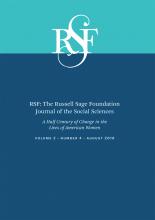Research Article
Open Access
Gender Differences in the Early Career Outcomes of College Graduates: The Influence of Sex-Type of Degree Field Across Four Cohorts
Kimberlee A. Shauman
RSF: The Russell Sage Foundation Journal of the Social Sciences August 2016, 2 (4) 152-193; DOI: https://doi.org/10.7758/RSF.2016.2.4.06
Kimberlee A. Shauman
aProfessor of sociology at the University of California, Davis

REFERENCES
- ↵
- Bergmann, Barbara R
- ↵
- Blau, Francine D.,
- Peter Brummund, , and
- Albert Yung-Hsu Liu
- ↵
- Bobbitt-Zeher, Donna
- ↵
- Brown, Charles, and
- Mary Corcoran
- ↵Carnevale, Anthony P., Jeff Strohl, and Michelle Melton. 2011. “What's It Worth? The Economic Value of College Majors.” Washington, D.C.: Georgetown University Center on Education and the Workforce.
- ↵
- Charles, Maria, and
- Karen Bradley
- ↵
- ↵Charles, Maria, and David Grusky. 2004. Occupational Ghettos: The Worldwide Segregation of Women and Men. Stanford, Calif.: Stanford University Press.
- ↵DiPrete, Thomas A., and Claudia Buchmann. 2013. The Rise of Women: The Growing Gender Gap in Education and What It Means for American Schools. New York: Russell Sage Foundation.
- ↵Eagly, Alice H., and Linda L. Carli. 2007. Through the Labyrinth: The Truth About How Women Become Leaders. Boston, Mass.: Harvard Business School Press.
- ↵England, Paula. 1992. Comparable Worth: Theories and Evidence. New York: Aldine de Gruyter.
- ↵England, Paula. 2006. “Toward Gender Equality: Progress and Bottlenecks.” In The Declining Significance of Gender? edited by Francine D. Blau, Mary C. Brinton, and David B. Grusky. New York: Russell Sage Foundation.
- ↵
- England, Paula,
- Paul Allison, , and
- Yuxiao Wu
- ↵
- England, Paula, and
- Su Li
- ↵Goldin, Claudia. 1990. Understanding the Gender Gap: An Economic History of American Women. Oxford: Oxford University Press.
- ↵
- ↵
- Goldin, Claudia,
- Lawrence Katz, , and
- Ilyana Kuziemko
- ↵
- Grogger, Jeff, and
- Eric Eide
- ↵
- Heijke, Hans,
- Christoph Meng, , and
- Ger Ramaekers
- ↵
- Jacobs, Jerry A
- ↵
- ↵
- ↵
- Joy, Lois
- ↵Kanter, Rosabeth M. 1977a. Men and Women of the Corporation. New York: Basic Books.
- ↵
- ↵
- ↵Koput, Kenneth W., and Barbara A. Gutek. 2010. Gender Stratification in the IT Industry: Sex, Status and Social Capital. Northampton, Mass.: Edward Elgar.
- ↵
- Levanon, Asaf,
- Paula England, , and
- Paul Allison
- ↵
- Logel, Christine,
- Gregory M. Walton, ,
- Steven J. Spencer, ,
- Emma C. Iserman, ,
- William von Hippel, , and
- Amy E. Bell
- ↵
- ↵
- Morgan, Laurie A
- ↵
- Moss-Racusin, Corinne A.,
- John F. Dovidio, ,
- Victoria L. Brescoll, ,
- Mark J. Graham, , and
- Jo Handelsman
- ↵National Center for Education Statistics. 1994. NLS-72 National Longitudinal Study of the High School Class of 1972. NCES Publication No. 1994487REV.
- ↵National Center for Education Statistics. 2003. Baccalaureate and Beyond Longitudinal Study (B&B:2000/01). {Restricted use data files}.
- ↵National Center for Education Statistics. 2004. Baccalaureate and Beyond Longitudinal Study (B&B:93/2003). {Restricted use data files}.
- ↵National Center for Education Statistics. 2012. 2008-09 Baccalaureate and Beyond Longitudinal Study: Restricted-Use First Follow-up Data Files and File Documentation. NCES Publication No. 2012245.
- ↵Reskin, Barbara F., and Paula Roos. 1990. Job Queues, Gender Queues: Explaining Women's Inroads into Male Occupations. Philadelphia, Pa.: Temple University Press.
- ↵
- Reuben, Ernesto,
- Paola Sapienza, , and
- Luigi Zingales
- ↵
- ↵
- ↵
- ↵
- ↵
- ↵
- ↵
- Sheltzer, Jason M., and
- Joan C. Smith
- ↵
- Sorensen, Elaine
- ↵
- Steele, Jennifer,
- Jacquelyn B. James, , and
- Rosalind Chait Barnett
- ↵
- ↵Xie, Yu, and Alexandra A. Killewald. 2012. Is American Science in Decline? Cambridge, Mass.: Harvard University Press.
In this issue
Gender Differences in the Early Career Outcomes of College Graduates: The Influence of Sex-Type of Degree Field Across Four Cohorts
Kimberlee A. Shauman
RSF: The Russell Sage Foundation Journal of the Social Sciences Aug 2016, 2 (4) 152-193; DOI: 10.7758/RSF.2016.2.4.06
Jump to section
Related Articles
- No related articles found.
Cited By...
- No citing articles found.





